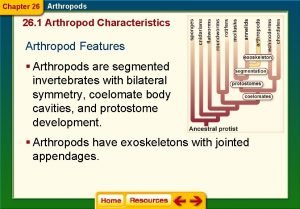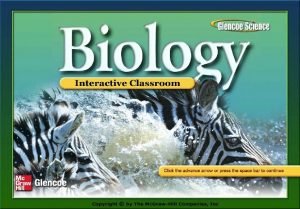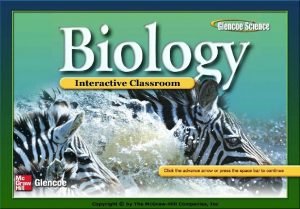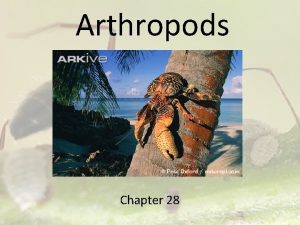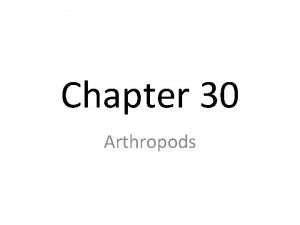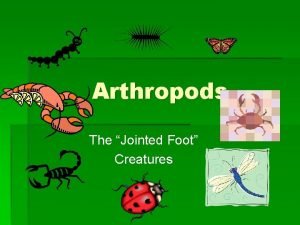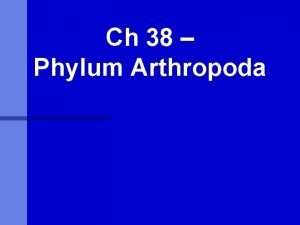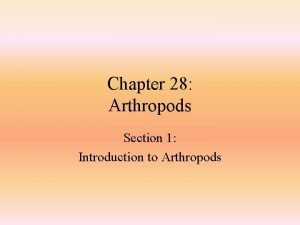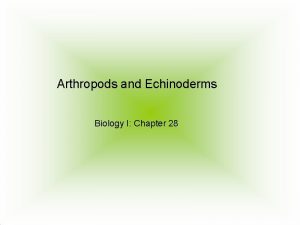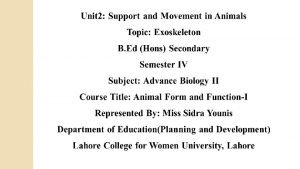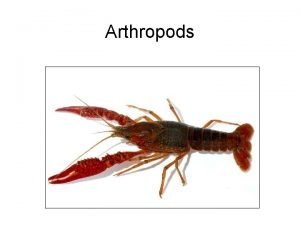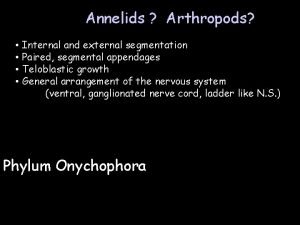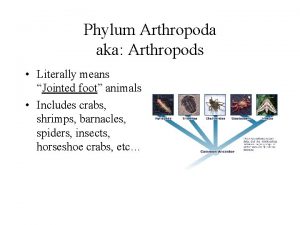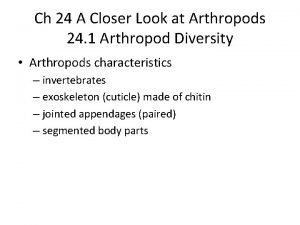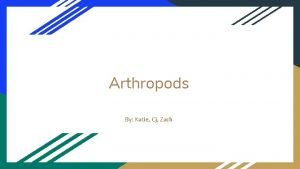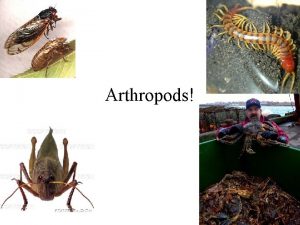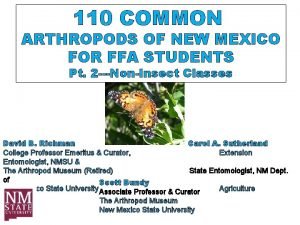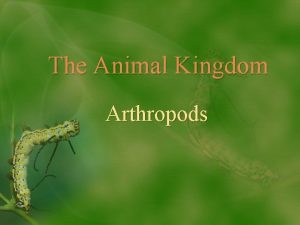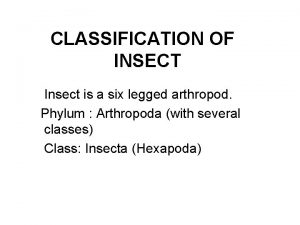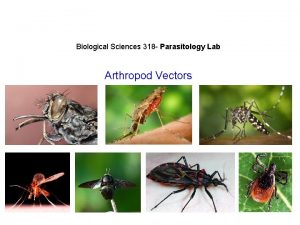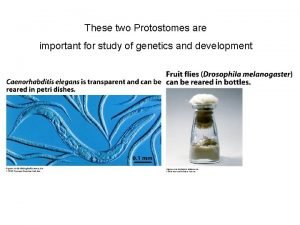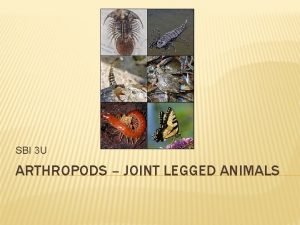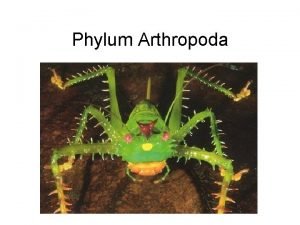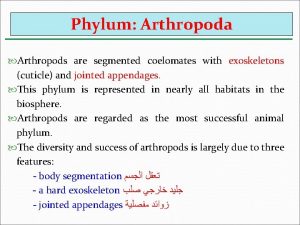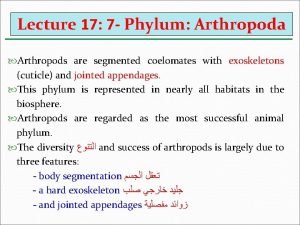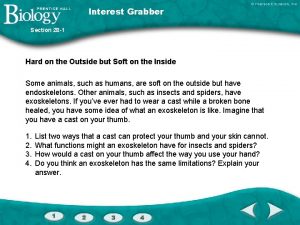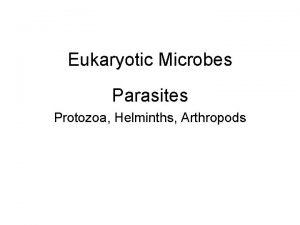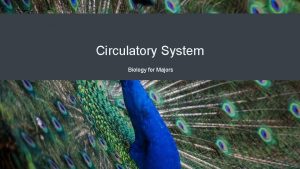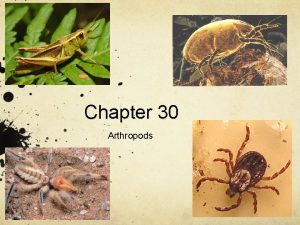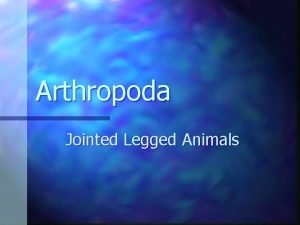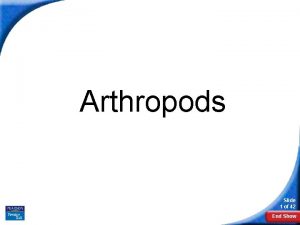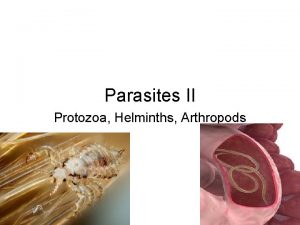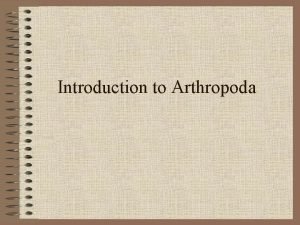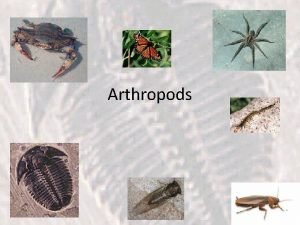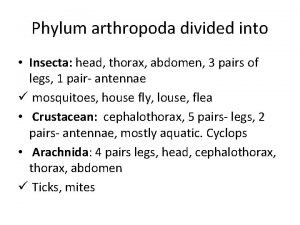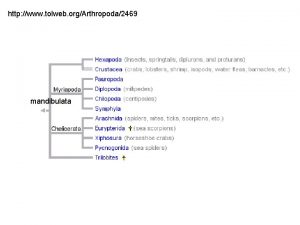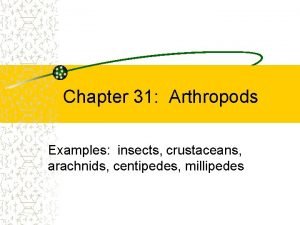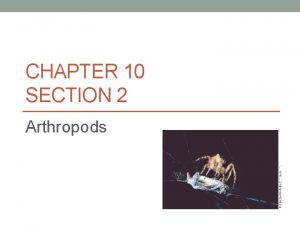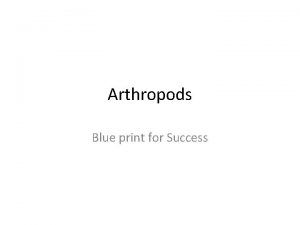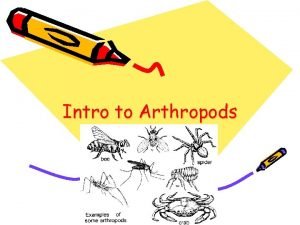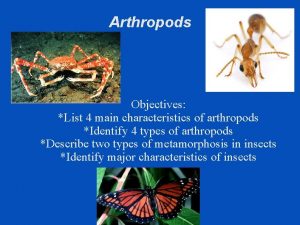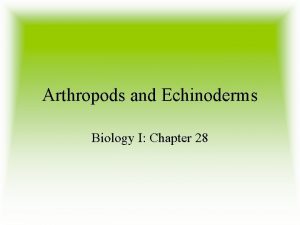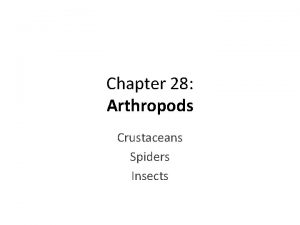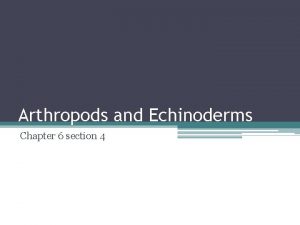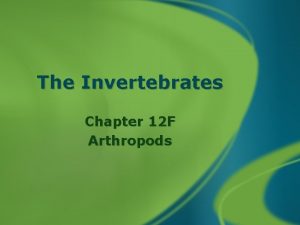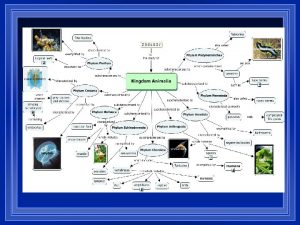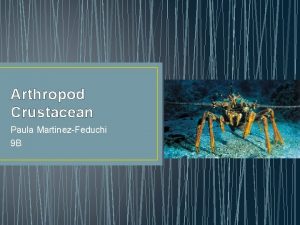Chapter 26 Arthropods 26 1 Arthropod Characteristics Arthropod












































- Slides: 44


Chapter 26 Arthropods 26. 1 Arthropod Characteristics Arthropod Features § Arthropods are segmented invertebrates with bilateral symmetry. § Arthropods have exoskeletons with jointed appendages.

• Include: • Chelicerata: spiders, ticks, mites, scorpions, horseshoe crab • Crustacea: crayfish, crabs, shrimp • Uniramia: centipede, millepede, all insects

Chapter 26 Arthropods 26. 1 Arthropod Characteristics Segmentation: 3 Main Segments § The head has mouthparts for feeding and various types of eyes. § The thorax is the middle body region to which legs and wings are attached. § The abdomen is the posterior end and bears additional legs and contains digestive structures and the reproductive organs.

Chapter 26 Arthropods 26. 1 Arthropod Characteristics Exoskeleton § Provides a framework for support and protection (from predators and water loss) § Made of chitin §Tough protein substance

Chapter 26 Arthropods 26. 1 Arthropod Characteristics Molting § Arthropods must shed their outer coverings in order to grow.

Chapter 26 Arthropods 26. 1 Arthropod Characteristics Jointed Appendages § Appendages of arthropods are adapted for a variety of functions, such as feeding, mating, sensing, walking, and swimming. Flies have jointed appendages.

Chapter 26 Arthropods 26. 1 Arthropod Characteristics Feeding and Digestion § Arthropods have a complete, one-way digestive system Leafcutter ant

Chapter 26 Arthropods 26. 1 Arthropod Characteristics Respiration § Arthropods obtain oxygen by using one of three structures—gills, tracheal tubes, or book lungs.

• Gills: feather-like structure, found under exoskeleton of water dwellers (crabs, crayfish, etc. )

• Tracheal Tube: most land arthropods (insects), air goes in and travels through tubes to various body parts

• Book lungs: blood filled membranes that absorb oxygen (spiders and scorpians)

• Circulation • Their circulatory systems transport nutrients and remove wastes.

Chapter 26 Arthropods

Chapter 26 Arthropods 26. 1 Arthropod Characteristics Excretion § Cellular wastes are removed from the blood through Malpighian tubules § Primitive kidney

Chapter 26 Arthropods 26. 1 Arthropod Characteristics Vision § A compound eye has many facets, which are hexagonal in shape. § Each facet sees part of an image. § The brain combines the images into a mosaic.

Chapter 26 Arthropods 26. 1 Arthropod Characteristics Hearing § Tympanum: sense organ which is a flat membrane used for hearing.

Chapter 26 Arthropods 26. 2 Arthropod Diversity Arthropod Groups § The crustaceans § The spiders and their relatives § The insects and their relatives Classifying Arthropods

Chapter 26 Arthropods

Chapter 26 Arthropods 26. 2 Arthropod Diversity Crustaceans § Most are aquatic and have two pairs of antennae, two compound eyes that can be on the tips of slender movable stalks, and mandibles for chewing. § Crustaceans possess branched appendages and have a free-swimming larval stage.

Chapter 26 Arthropods 26. 2 Arthropod Diversity § Most crustaceans, such as crayfishes, lobsters, and crabs, have five pairs of legs. § The first pair of legs—the chelipeds—has large claws adapted to catch and crush food. § Behind the next four pairs of walking legs are the swimmerets, appendages that are used for reproduction and as flippers during swimming.

Chapter 26 Arthropods 26. 2 Arthropod Diversity Spiders and Their Relatives § Most arachnids have two body sections— a cephalothorax and an abdomen—and four pairs of jointed appendages.

§ An arachnid’s most anterior pair of appendages is modified into mouthparts called chelicerae.

§ The second pair of appendages is called the pedipalps.

Chapter 26 Arthropods 26. 2 Arthropod Diversity Spiders § Spiders are capable of constructing only specific kinds of webs. § A spider secretes digestive enzymes onto its prey. § The spider ingests the softened food.

Chapter 26 Arthropods 26. 2 Arthropod Diversity Reproduction § A male spider stores sperm in a cavity on his pedipalps. § The male inserts the sperm into the female. § The female lays her eggs in a cocoon spun of spider silk. § There can be as many as 100 eggs in one cocoon.

Chapter 26 Arthropods 26. 2 Arthropod Diversity § Other members of class Arachnida are ticks, mites, and scorpions. Tick Scorpion

Chapter 26 Arthropods 26. 2 Arthropod Diversity Horseshoe Crabs § Horseshoe crabs have remained unchanged since the Triassic Period more than 200 million years ago. § The chelicerae, pedipalps, and the next three pairs of legs are used for walking and getting food from the bottom of the sea. § They feed on annelids, mollusks, and other invertebrates.

Chapter 26 Arthropods 26. 2 Arthropod Diversity § Horseshoe crabs come to shore to reproduce at high tide. Horseshoe crab

Chapter 26 Arthropods 26. 3 Insects and Their Relatives Diversity of Insects § Arthropods make up about three-fourths of all named animal species. § About 80 percent of arthropods are insects.

Chapter 26 Arthropods 26. 3 Insects and Their Relatives External Features § Three body areas—the head, thorax, and abdomen

Chapter 26 Arthropods 26. 3 Insects and Their Relatives § Head structures include antennae, compound eyes, simple eyes, and mouthparts. § Insects have three pairs of legs and generally two pairs of wings on the thorax.

Chapter 26 Arthropods

Chapter 26 Arthropods 26. 3 Insects and Their Relatives § Insect legs are adapted to a variety of functions. § Legs with claws enable beetles to dig in soil or crawl under bark. § Sticky pads on the ends of walking legs enable flies to walk upside down. § Legs adapted for collecting pollen § Legs adapted to jumping § Legs adapted to skimming over the surface of water

Chapter 26 Arthropods 26. 3 Insects and Their Relatives § Insects’ mouthparts are adapted to the food they eat.

Chapter 26 Arthropods

Chapter 26 Arthropods 26. 3 Insects and Their Relatives § Insect wings are outgrowths of the body wall. § Wings are formed of a thin double membrane of chitin, and they have rigid veins that give the wings strength.

Chapter 26 Arthropods 26. 3 Insects and Their Relatives § Insects have a variety of adaptations in their sense organs. § Hair-like structures that are sensitive to touch, pressure, vibration, and odor § Detect airborne sounds with their tympanic organs § Chemical receptors for taste and smell are located on mouthparts, antennae, or legs.

Chapter 26 Arthropods 26. 3 Insects and Their Relatives Complete Metamorphosis § Most insects develop through the four stages of complete metamorphosis—egg, larva, pupa, and adult.

Chapter 26 Arthropods

Chapter 26 Arthropods 26. 3 Insects and Their Relatives Incomplete Metamorphosis § Insects that undergo incomplete metamorphosis hatch from eggs as nymphs. § After several molts, young nymphs become winged adults.

Chapter 26 Arthropods 26. 3 Insects and Their Relatives Centipedes and Millipedes § Centipedes have long, segmented bodies, and each segment has one pair of jointed legs. § The first pair of appendages is modified to form poison claws. § Most species of centipedes are not harmful to humans. Centipede

Chapter 26 Arthropods 26. 3 Insects and Their Relatives § Millipedes have two pairs of appendages on their abdominal segments and one pair on their thorax. § Walk with a slow, graceful motion § They do not have poison claws and feed primarily on damp and decaying vegetation. Millipede

Chapter 26 Arthropods
 Chapter 26 section 1 arthropod characteristics
Chapter 26 section 1 arthropod characteristics Chapter 26 section 3 insects and their relatives
Chapter 26 section 3 insects and their relatives Characteristic of arthropods
Characteristic of arthropods Arthropod characteristics
Arthropod characteristics Characteristics of arthropods
Characteristics of arthropods Characteristics of athropods
Characteristics of athropods Phylum arthropoda characteristics
Phylum arthropoda characteristics Section 36-1 review phylum arthropoda
Section 36-1 review phylum arthropoda Arthropod groups
Arthropod groups 28-1 introduction to arthropods
28-1 introduction to arthropods Arthropods and echinoderms
Arthropods and echinoderms Arthropod exoskeleton
Arthropod exoskeleton Jointed appendages definition biology
Jointed appendages definition biology Segmentation arthropods
Segmentation arthropods Daphnia
Daphnia Means jointed feet
Means jointed feet Arthropod
Arthropod Arthropod
Arthropod Common arthropods
Common arthropods Arthropod
Arthropod Characteristics of parasites
Characteristics of parasites 6 legged arthropod
6 legged arthropod Arthropod subkingdom
Arthropod subkingdom Are arthropods protostomes or deuterostomes
Are arthropods protostomes or deuterostomes Central and peripheral nervous system
Central and peripheral nervous system Joint footed animals are called
Joint footed animals are called Subphylum
Subphylum Jointed foot phylum
Jointed foot phylum Segmented coelomates
Segmented coelomates Arthropods segmentation
Arthropods segmentation Section 28-3 insects answer key
Section 28-3 insects answer key Summary of hygiene
Summary of hygiene Ascaris lumbricoides
Ascaris lumbricoides Arthropods circulatory system
Arthropods circulatory system Arthropods structure
Arthropods structure Jointed appendages
Jointed appendages Joint legged animals
Joint legged animals Section 28-1 introduction to the arthropods
Section 28-1 introduction to the arthropods Proserkoid
Proserkoid Jointed appendages
Jointed appendages Introduction of arthropods
Introduction of arthropods Phylum arthropoda common name
Phylum arthropoda common name Head thorax abdomen
Head thorax abdomen Arthropoda
Arthropoda Examples of centipedes
Examples of centipedes
